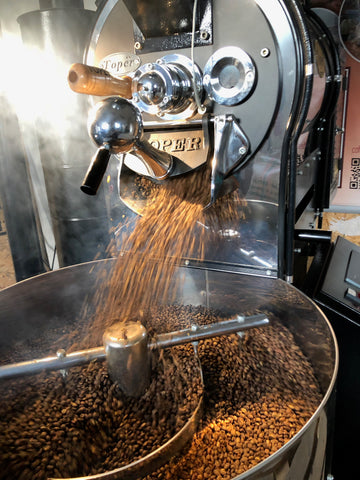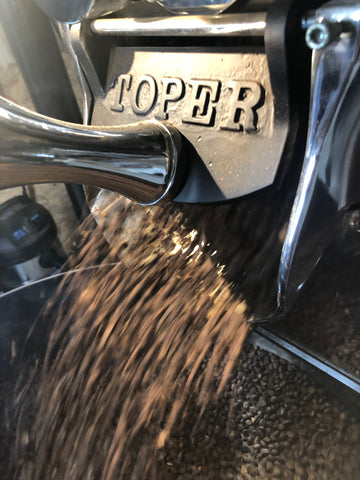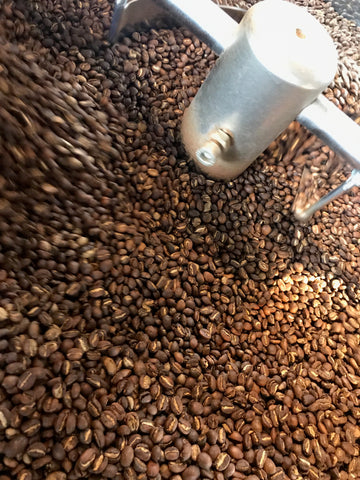
The preparation of coffee, including roasting, is something that not many people know about, roasting is not an easy task if you take it seriously.
However, here we have prepared a guide explaining in a little more depth the seemingly simple aspects of this important process.
Each of the processing steps the coffee goes through is important for the roasting step, which is usually done in the country of consumption rather than in the country of origin. Dried raw beans are packaged for shipment around the world, they are dense and still contain moisture making them take up less volume for the same weight. Raw coffee beans are also quite shelf stable compared to roasted beans, and with most growing regions now using Grain Pro bags to seal in freshness even more - when green raw coffee is received at the roastery it will be in as good condition as when it left the growing region.

The roasting process involves heating, cooking or drying the beans in a special coffee roaster that transforms the green coffee beans into the special flavours and aromas for the final cup.
Roasting removes moisture and changes the chemical composition of the coffee beans through pyrolysis to obtain the brightness, acidity, flavours and aromas in the brewed coffee.
Roasting time
It can vary depending on the amount of coffee beans, their moisture content and the type of bean. Another factor that can vary is the age of the beans, as well as the climate of the roasting location. It usually takes about 15 minutes and in the first few minutes its weight is reduced by 20% and it gains 60% in volume.
This requires a master roaster who pays attention to roasting time, roasting temperature and even appearance and fragrance in a skilful way.

Common coffee roasters are heated by propane gas and use electricity to move the drums where the coffee is roasted. Temperatures range from 370 to 540 degrees Fahrenheit (188 to 282 degrees Celsius).
Colour groups
Light Roast or Cinnamon Roast
Light brown colour with a high degree of acidity and no oil on the surface.
Medium Roast
Medium brown colour, very strong flavour and no oil on the surface.
Medium Dark Roast (Full City)
Dark in colour, with a small layer of oil on the surface and a sweet and sour taste with low acidity.
Dark roast (Espresso)
Dark roast is dark, with a high bitterness and an oily appearance, and the flavour of the roast dulls the original flavour of the bean.
It is achieved after the second cracking of the beans.

Flavour and caffeine profiles depending on the roasting process
Caramelisation
Due to roasting, it is crucial to understand caramelisation and the Maillard reaction, both of which take place before the first crack.
The Maillard reaction is the chemical reaction between sugars and amino acids that allows the beans to brown. After these reactions, the natural sugars are dissipated by the heat and caramelisation occurs, resulting in the first crack.
If the heat continues, the sugars dry out and produce bitterness, these reactions are difficult to predict. Even so, it should be borne in mind that the lighter the roast the more acidity it will have and the darker the roast the more sweetness it will present, depending on the time it remains in the roaster.
Caffeine
In a very similar way to caramelisation, caffeine is also affected, with lighter roasts having a higher amount of caffeine and darker roasts having slightly less caffeine than lighter roasts, which is not very noticeable.
Among the profiles we can find the dark roast which varies in two forms, the French roast and the Italian roast. The French roast is known for its dark brown colour, a little oily and with a full-bodied result in the cup.
The Italian roast is a little darker and is mostly used for espresso coffee, as it is the most suitable.
Degassing the coffee
Degassing is important in the preparation after roasting the beans, as they contain carbon dioxide (Co2) in large volumes and a number of other gases. These gases are released for several days if the degassing process is not carried out, we could completely damage the flavour and aroma compounds by creating bubbles when the grind and water come into contact.
How long can roasted coffee be stored for?
Roasted coffee should be stored in a cool, dry environment for one year or less. Roasted and ground coffee, on the other hand, has many disadvantages in maintaining its shelf life, as it is more exposed to humidity and heat, so it should be hermetically sealed after grinding to preserve its aroma.

